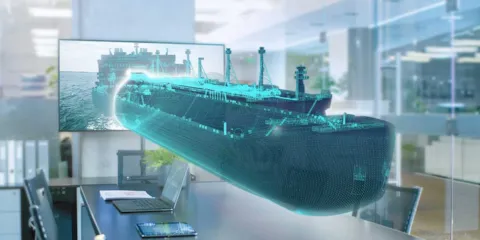DNV 3D Approval Platform
In the fast-evolving shipbuilding industry, the transition from 2D drawings to 3D ship design for plan approvals is gathering steam. This will bring many advantages, including reduced workload, costs, and time to market, and improvements in quality.
3D models will replace traditional drawings for approval of ships
With shipping embracing digital transformation, and most designers already employing 3D modeling software for shipbuilding drawings, there is a compelling push to utilize these advanced tools for streamlining and accelerating the approval process. Today, most designers extract conventional 2D drawings from 3D modeling software and use this for the approval process. The obvious next step is to eliminate this process and perform the entire review process digitally instead of manually.
Navigating Challenges: Towards Standardization in Shipbuilding Industry
The main barrier to achieving this is the lack of a standard process and platform. The diversity of CAD (Computer Aided Design) software applications and digital engineering tools creates significant technical and business challenges such as:
- Data integrity issues across diverse systems and applications
- Expensive and intricate system integration
- No unified digital standard supporting classification societies' requirements
The aim is, therefore, to standardize the format and process for submitting 3D design data to DNV as classification society for approval.
Introducing the OCX Standard: A revolutionary leap
In 2016, DNV established the Joint Industry Project, APPROVED, initiating a journey that led to the Open Class 3D Exchange standard (OCX), an open standard exchange format which ensures interoperability across all the different CAD applications.
This shift enables seamless class reviews of diverse 3D ship design and facilitates the transition from 2D drawings to 3D model documentation and verification. Additionally, the integration of DNV Calculation tool, Nauticus Hull, for efficient rule checking in this process, signifies an advanced step in design verification.
Benefits of OCX:
- Reduced shipyard workload and need for drawings
- Decreased time to market and cost
- Enhanced quality and early involvement in design
- Improved calculation processes and efficiency
- Augmented transparency and support for automation
- Concise, informative, and effectively organized content
Working with us: Model-based approval with DNV
DNV promotes the exchange of 3D OCX models with all customers who are using an OCX-enabled 3D design tool that enables the export of the OCX file format. These customers can choose to submit a 3D OCX model as design documentation instead of traditional 2D structural drawings.
DNV offers three ways for customers to interact with DNV:
- Efficient Rule Check using Nauticus Hull by the direct import of the 3D OCX model exported from the CAD system.
- Early Design Review/Pre-contract based on the review of an early 3D OCX model.
- A full model-based approval process covering the hull discipline.
A prerequisite for a designer/yard to engage with DNV and the model-based approval platform is the ability to deliver a 3D design model on the OCX format in the basic design stage.
From the first scratch of your newbuilding project onwards, we provide plan approval to grant a rule compliant and safe ship which is the basis for different certificates.
Read more about Plan Approval
How it works:
Embark on a seamless model-based approval journey with DNV, using the 3D OCX models.
- Upload the 3D OCX model to DNV.
- Review and rule calculations performed using DNV’s calculation tools like Nauticus Hull.
- Receive immediate design feedback and make required changes.
- Result: A new vessel delivered with a shorter time-to-market, improved traceability, and quality.

Ready to navigate the future of shipbuilding? Unveil the transformative capabilities of DNV's 3D Approval Platform and Digital Twin technology today.
For enquiries, contact: Olav Sverre Bergli, Head of Department, Ship Structures & Stability, DNV




